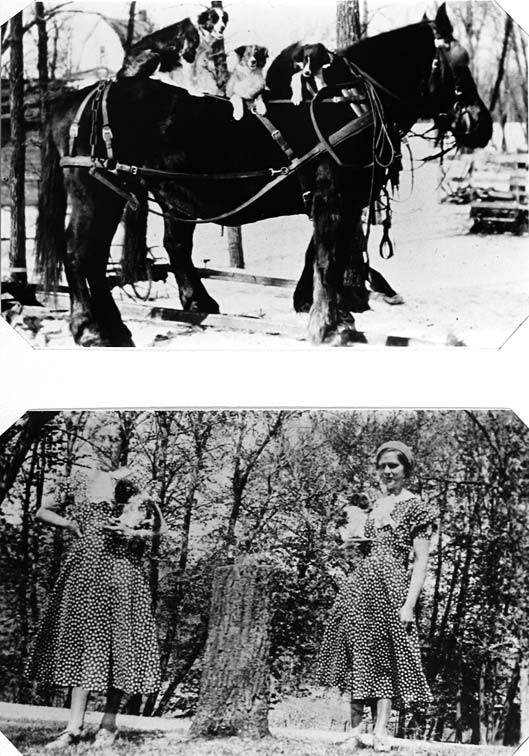Animals in every picture
Top: Perley and two of her pups on horseback, 1932. At least one big team was sharp shod all winter for ice and snow. Sharp shoes had changeable calks, just like steel chisels -- two in front and one in each back corner of the shoe. The new camera, Donald and Marjory agreed, would be used to take pictures of people only if there was an animal in the picture, too. The album shows that they almost invariably stuck to the bargain!
Bottom: Marjory and her "twin sister" with puppies is a trick photograph in which the film was exposed with Marj on one side of the stump and a black card placed over half the lens. She and the black card both switched sides and the film was exposed again. This works very well if the background is dark enough, but light bleeding through the trees works against the illusion. Marjory and Donald had quite a repertoire of photographic tricks and really worked on the pictures.
Excerpt from Donald B. Johnson manuscript:
"One of the first years, [Pa] built an ice house on the farm. It's still called that, but has only held bolts and junk for a long time, now. The door faced north when it was an ice house, making it easier to fill. We could back the sleigh loads of ice to the door, by going a little past and then angling downhill. There was no foundation under it, but we later dug away some on the west side and made a sort of lean-to pole shed for the Model T. Later, we put a foundation between the posts, which is the west foundation of the ice house now. [12.78-2]
"One of the hardest jobs of the whole year was sawing the ice out in the middle of Christina Lake to fill the ice house: cutting blocks by hand with a big six or seven-foot ice saw, hauling them home with horses and sliding them on skids into the ice house. I think Sam Schram helped [Pa] the first years, until I left school at 14; after that, I was the helper. [12.78-3]
"The first years, Pa sawed [ice] both ways in place, out on the lake, to form blocks, when the lake ice was 18 to 24 inches thick. That was a lot of sawing. In later years, we got Earl Anderson to bring out an 'ice plow,' which was a long row of chisels fastened to the bottom of a beam like a breaking plow beam. We pulled it with horses and later with his Model T truck. It didn't plow all the way, but the blocks would break off with a chisel when you got a hole opened along one side." [12.78-supplement]
"I never did last very long sawing, but from then on, I had the job of cleaning all the sawdust out of the ice house and putting it back in, over and around the ice. There was a lot of it, and if I left it too long in the ice house it would all be frozen solid, because it was always wet, and have to be picked loose. If I did it too early in the winter, it would all freeze solid in the pile outside and have to be picked loose out there. [12.78-4]
"The sawdust would rot and more would have to be added every other year or so. Pa could usually get a big wagon boxful or two from Sivert Guldseth, who had a small lumber saw on his farm, a couple of miles northeast of town. [12.78-5]
"When the ice was 'in' and the sawdust back in again, then we could take a deep breath and enjoy the winter." [12.78-supplement]
Previous • Next • Contents • About • Sitemap • Home
